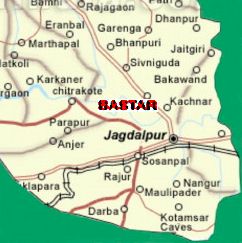|
Thyroid Dysfunctions in
Tribal Women of the
Bastar Region of Chattisgharh, India

Full
Text Free
(pdf)
Lincy K.
Skaria, MSc,1*
Purnima Dey Sarkar, MSc, PhD,2
Gopinath Agnihotram, MSc,1
Amar Singh Thakur, MSc, PhD,1
Girish Pamidamarri, Msc1
1Govt. Medical College, Jagdalpur, (C.G.) 494001, India
2MGM Medical College,
Indore, MP, India
*Correspondence: Mrs.
Lincy K. Skaria, Assistant
professor
Department of Biochemistry,
Govt. Medical College
Jagdalpur, Chattisgharh-494001,
India.
Email:
linsey@rediffmail.com,
Phone: 09754158156
|
 Abstract.
Introduction: The Bastar region receives heavy rainfall
and frequent flooding, leading to
depletion of iodine from the
superficial soil layer. Also,
consumption of sea food is deficient
in this area. Hence, these sources
of iodine deficiency raises concerns
about the thyroid status of Bastar
residents. Thyroid dysfunction is a
common endocrine disorder that has
signs and symptoms that mimic those
of other common diseases.
Methods:
The signs and symptoms of 150
subjects who visited the General
Medicine Department, Govt. Medical
College, in Jagdalpur raised the
possibility that they had thyroid
disease. That their signs and symptoms
were not explained by non-thyroid
diseases constituted the study
inclusion criterion. The subjects
were analyzed for levels of tri-iodothyronine
(T3), tetra-iodothyronine (T4), and
thyroid stimulating hormone (TSH).
Data was analyzed by Anova tests and
correlation analyses.
Results:
Based
on their thyroid hormone and TSH
levels, subjects were classified
into four groups: 20.66% were
euthyroid, 59.33% were
hypothyroidism, 12.66% had subclinical hypothyroidism, and
7.33% were hyperthyroidism. Some males (n = 15, 10%)
but mostly females
(n = 135, 90%) were included in the
study. T3, T4 and TSH
levels significantly
differed between all four groups (p < 0.001). The study
also analyzed the correlation
between T3, T4 and TSH in different
groups.
Conclusion:
Subclinical hypothyroidism should be treated with thyroid hormone therapy
to prevent progression to overt
hypothyroidism and other clinical
manifestations. Inclusion of non-goitrogenic
foods and exclusion of goitrogenic
foods also should be recommended to
patients who have thyroid
dysfunction. Abstract.
Introduction: The Bastar region receives heavy rainfall
and frequent flooding, leading to
depletion of iodine from the
superficial soil layer. Also,
consumption of sea food is deficient
in this area. Hence, these sources
of iodine deficiency raises concerns
about the thyroid status of Bastar
residents. Thyroid dysfunction is a
common endocrine disorder that has
signs and symptoms that mimic those
of other common diseases.
Methods:
The signs and symptoms of 150
subjects who visited the General
Medicine Department, Govt. Medical
College, in Jagdalpur raised the
possibility that they had thyroid
disease. That their signs and symptoms
were not explained by non-thyroid
diseases constituted the study
inclusion criterion. The subjects
were analyzed for levels of tri-iodothyronine
(T3), tetra-iodothyronine (T4), and
thyroid stimulating hormone (TSH).
Data was analyzed by Anova tests and
correlation analyses.
Results:
Based
on their thyroid hormone and TSH
levels, subjects were classified
into four groups: 20.66% were
euthyroid, 59.33% were
hypothyroidism, 12.66% had subclinical hypothyroidism, and
7.33% were hyperthyroidism. Some males (n = 15, 10%)
but mostly females
(n = 135, 90%) were included in the
study. T3, T4 and TSH
levels significantly
differed between all four groups (p < 0.001). The study
also analyzed the correlation
between T3, T4 and TSH in different
groups.
Conclusion:
Subclinical hypothyroidism should be treated with thyroid hormone therapy
to prevent progression to overt
hypothyroidism and other clinical
manifestations. Inclusion of non-goitrogenic
foods and exclusion of goitrogenic
foods also should be recommended to
patients who have thyroid
dysfunction.
Keywords • Hypothyroidism • Hyperthyroidism •
Subclinical hypothyroidism • Thyroid
stimulating hormone • Tri-iodothyronine
(T3) • Tetra-iodothyronine (T4)
Citation: Skaria, L.K., Sarkar, P.D., Agnihotram, G.,
Thakur, A.S., and Pamidamarri, G.:
Thyroid dysfunctions in tribal women
of the Bastar Region of Chattisgharh,
India. Thyroid Science, 6(6):1-5, 2011.
Full
Text Free
(pdf)

© 2011
Thyroid Science |
|
